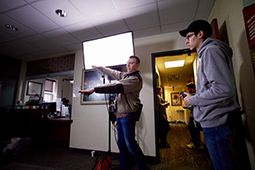
Photo courtesy of: Scripps College of Communication
Ohio University alumnus and cinematographer Matt Love, center, discusses lighting setups with OHIO student Elijah Jimenez.
The best way to learn how to do something often is direct experience.
In training for patient care in Appalachia, a new virtual reality program created through Ohio University’s Game Research and Immersive Design (GRID) Lab simulates the experience of working with Appalachian patients and offers important insight into regional values and culture that can inform the ways in which practitioners can best provide care.
Faculty with the College of Health Sciences and Professions and the Heritage College of Osteopathic Medicine created a pair of characters designed to demonstrate the challenges faced by people in Appalachia. The characters are then portrayed in a series of videos, mostly presented in virtual reality (VR) simulations created by the GRID Lab in the Scripps College of Communication, with assistance from master’s students in the College of Fine Arts and the Scripps College MFA in Communication Media Arts.
The videos will be available to health care providers for training purposes. The VR series – developed for the Ohio Department of Medicaid – will have an accompanying website with additional educational resources. Project leaders hope this project will inspire other collaborative efforts, using talents and expertise from multiple fields to improve health care in southeast Ohio.
The Heritage College and the College of Health Sciences and Professions each led the creation of a character:
- Destiny, created by CHSP, is a female in her early 20s. She’s from Appalachia; she’s pregnant, not married, and her parents aren’t really in the picture. She’s also addicted to opioids.
- Lula Mae Tate, created by the Heritage College, is a woman from Appalachia, in her 70s, who has type 2 diabetes. She tries to keep her disease under control on a limited income, but life keeps interfering. As matriarch of her extended family, Lula Mae cares for her grandchildren and son, a disabled veteran. Faced with a choice between what’s best for her family or her health, she’ll choose her family.
While the characters are not based upon real individuals, the characters were developed to illustrate situations faced frequently in Appalachia.
The VR project is designed to educate health care professionals about aspects of Appalachian culture and help them recognize implicit biases that may complicate provision of care to patients in the region. Cultural factors that can inform decisions include a strong sense of community and “taking care of one’s own,” pride in self-sufficiency, and a wariness of those who come to the region from elsewhere. The VR series is part of a larger project, “Virtual Reality Simulations to Address Provider Bias and Cultural Competency,” being funded by a grant from Ohio’s Medicaid Technical Assistance and Policy Program (MEDTAPP) for $924,631. This includes $453,069 from MEDTAPP and $471,562 in matching funds from the University.
A person putting on the virtual reality goggles will step into episodes in which the characters interact with their health care providers, including doctors, nurses and pharmacists, as well as social workers and families.
The project was led by co-primary investigators Dr. John McCarthy, Ph.D., CCC-SLP, CHSP associate professor of communication sciences and disorders and interim associate dean for research and graduate studies in Health Sciences and Professions, and Dr. Deborah Henderson, MSN, BSN, CNE, professor and director of the School of Nursing. Other investigators on the project include Dr. Elizabeth Beverly, assistant professor of family medicine at the Heritage College of Osteopathic Medicine; John Bowditch, director of the Game Research and Immersive Design (GRID) Lab; and Eric Williams, professor in the Scripps College of Communication.
The GRID Lab project was produced by Carrie Love, who also contributed to scriptwriting and co-directed the Lula Mae series with Williams. Josh Crook, MFA student in the Scripps College MFA program, directed the Destiny series. Matthew Love, a virtual reality production coordinator and cinematographer at the GRID Lab, handled cinematography and post-production coordination for both series.
“We tried to think about what kind of issues people are confronting and what do we want them to know from a cultural competency perspective,” McCarthy said. “We want our providers to really think about what they’re bringing to interactions with people who live in this region.”
“This has been the biggest interdisciplinary project that I’ve been a part of,” Williams said. “I’ve done a lot of smaller collaborations, but this has been the most fun as far as getting everybody on the same team. And it’s a great team! I’m amazed at how well everybody works together. To me, this is exactly what a university like Ohio University should be doing.”